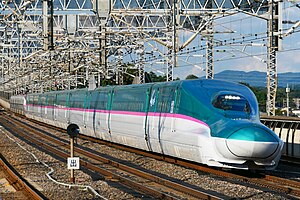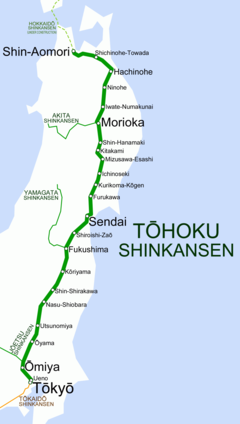
A | B | C | D | E | F | G | H | CH | I | J | K | L | M | N | O | P | Q | R | S | T | U | V | W | X | Y | Z | 0 | 1 | 2 | 3 | 4 | 5 | 6 | 7 | 8 | 9
| Tōhoku Shinkansen | |||
|---|---|---|---|
 E5 Series Shinkansen set U2 coupled to an E6 Series Shinkansen set on a Hayabusa service towards Tokyo, August 2023 | |||
| Overview | |||
| Native name | 東北新幹線 | ||
| Status | Operational | ||
| Owner | |||
| Locale | Tokyo; Saitama, Tochigi, Fukushima, Miyagi, Iwate and Aomori Prefectures | ||
| Termini | |||
| Stations | 23 | ||
| Color on map | Green (#41934c) | ||
| Service | |||
| Type | High-speed rail (Shinkansen) | ||
| System | Shinkansen | ||
| Services | |||
| Operator(s) | |||
| Depot(s) | Tokyo, Oyama, Nasushiobara, Sendai, Morioka, Shin-Aomori | ||
| Rolling stock | |||
| History | |||
| Opened | 23 June 1982 (Ōmiya - Morioka) 4 December 2010 (Full line) | ||
| Technical | |||
| Line length | 674.9 km (419.4 mi) | ||
| Number of tracks | Double-track | ||
| Track gauge | 1,435 mm (4 ft 8+1⁄2 in) standard gauge | ||
| Minimum radius | 4,000 m (2.5 mi; 13,000 ft) | ||
| Electrification | 25 kV 50 Hz AC overhead catenary | ||
| Operating speed | 320 km/h (200 mph) Around 2027: 360 km/h (225 mph) | ||
| Signalling | Cab signalling | ||
| Train protection system | DS-ATC | ||
| |||
The Tōhoku Shinkansen (東北新幹線) is a Japanese high-speed Shinkansen rail line, connecting Tokyo with Aomori in Aomori Prefecture in a route length of 674.9 km (419.4 mi), making it Japan's longest Shinkansen line. It runs through the more sparsely populated Tōhoku region of Japan's main island, Honshu, and was extended as the Hokkaido Shinkansen through the Seikan Tunnel to Shin-Hakodate-Hokuto (this section opened March 2016) and is expected to be extended to Sapporo by 2030. It has two Mini-shinkansen branch lines, the Yamagata Shinkansen and Akita Shinkansen. The line is operated by East Japan Railway Company (JR East).
Services
There are four services in operation:
- Hayabusa, Tokyo – Shin-Aomori/Shin-Hakodate-Hokuto limited-stop, starting 5 March 2011
- Hayate, Morioka/Shin-Aomori - Shin-Hakodate-Hokuto limited-stop, starting 26 March 2016 (the name has been in use since 1 December 2002)
- Yamabiko, Tokyo – Sendai limited-stop, and all-stations to Morioka, starting June 1982
- Nasuno, Tokyo – Oyama/Nasushiobara/Kōriyama all-stations, starting 1995
One service has been discontinued:
- Aoba, Tokyo – Sendai all-stations, June 1982 – October 1997 (consolidated with Nasuno)
Through trains on the Akita Shinkansen and Yamagata Shinkansen lines also run on Tōhoku Shinkansen tracks from Morioka and Fukushima respectively.
As of March 2021, the maximum line speed is 110 km/h (68 mph) between Tokyo and Ueno, 130 km/h (81 mph) between Ueno and Ōmiya, 275 km/h (171 mph) between Ōmiya and Utsunomiya, 320 km/h (199 mph) between Utsunomiya and Morioka, and 260 km/h (162 mph) between Morioka and Shin-Aomori.[1][2][3]
On 30 October 2012, JR East announced that it is pursuing research and development to increase speeds to 360 km/h (224 mph) on the Tohoku Shinkansen.[4] Work seems to be ongoing to upgrade the section between Morioka and Shin-Aomori to 320 km/h (199 mph), primarily in the form of improved sound barriers. This should make operating at 360 km/h (224 mph) possible, if the improved noise dampening techniques being tested using the ALFA-X test train are successful.[5] Upgrade works on this section started in October 2020, and are expected to take seven years to complete.[6]
List of stations
Legend:
| ● | All trains stop |
|---|---|
| ▲ | Some trains stop |
| | | All trains pass |
Rolling stock
As of March 2024, the following types are used on Tohoku Shinkansen services.
- E2 series: Yamabiko / Nasuno services
- E3 series: Tsubasa / Yamabiko / Nasuno services
- E5 series: Hayabusa / Hayate / Yamabiko / Nasuno services
- E6 series: Komachi / Hayabusa / Yamabiko / Nasuno services
- E8 series: Tsubasa / Yamabiko / Nasuno services[7]
- H5 series: Hayabusa / Hayate / Yamabiko / Nasuno services
-
E2 series
-
E3 series
-
E5 series
-
E6 series
-
H5 series
Former rolling stock

- 200 series: Yamabiko / Nasuno / Aoba services (1982 – November 2011)[8]
- 400 series: Tsubasa / Nasuno services (July 1992 – April 2010)
- E1 series: Max Yamabiko / Max Aoba services (July 1994 – December 1999)
- E4 series: Max Yamabiko / Max Nasuno services (1999 – September 2012)
-
200 series
-
A 400 series train on a Tsubasa service at Yonezawa Station in March 2005
-
E1 series
-
E4 series
Non-revenue-earning types
-
E926 East i train at Omiya Station, May 2001
Timeline
History
- 28 November 1971: Construction starts on the line.
- 23 June 1982: The Ōmiya–Morioka section opens.[9]
- 14 March 1985: The Ueno–Ōmiya section opens.
- 20 June 1991: The Tokyo–Ueno section opens.
- October 1998: 1 billionth passenger carried on Tōhoku, Joetsu and Nagano Shinkansen lines.
- 1 December 2002: The Morioka–Hachinohe section opens.
- 13 April 2010: Test running starts on the extension from Hachinohe to Shin-Aomori.[10]
- 4 December 2010: The extension from Hachinohe to Shin-Aomori opens.[11]
- 5 March 2011: New Hayabusa services operating at 300 km/h (190 mph) commence operation between Tokyo and Shin-Aomori using new E5 series trainsets.[12]
- 23 June 2012: The line's 30th anniversary was celebrated, with approximately 1.93 billion passengers having been transported on the line.[13]
From Shin-Aomori, the line continues to Shin-Hakodate in Hokkaido (148.9 km or 92.5 mi, since March 26, 2016 under the name Hokkaido Shinkansen), passing through the world's longest undersea railway tunnel, the Seikan Tunnel. A further 211.3 km (131.3 mi) to Sapporo is due to open by 2030.
The mountainous terrain that the line passes through has necessitated heavy reliance on tunnels. The Iwate-Ichinohe Tunnel on the Morioka–Hachinohe stretch, completed in 2000, was briefly the world's longest land rail tunnel at 25.8 km (16.0 mi), but in 2005 it was superseded by the Hakkōda Tunnel on the extension to Aomori, at 26.5 km (16.5 mi). In 2007 the Lötschberg Base Tunnel (34.57 km or 21.48 mi), and in 2010 the Gotthard Base Tunnel (57 km or 35 mi, bored through and due in service by 2016) in Switzerland superseded both.
2011 Tohoku earthquake and tsunami
On the afternoon of 11 March 2011, services on the Tohoku Shinkansen were suspended as a result of the Tōhoku earthquake and tsunami. JR East estimated that around 1,100 repairs would be required for the line between Omiya and Iwate-Numakunai, ranging from collapsed station roofs to bent power pylons.[14]
Limited service on the line was restored in segments: Tokyo to Nasushiobara was re-opened on 15 March, and Morioka to Shin-Aomori was re-opened on 22 March.[15] The line between Morioka and Ichinoseki re-opened on 7 April, Nasushiobara and Fukushima on 12 April, and the rest of the line on or around 30 April, although not at full speed or a full schedule.[16][17][18] The trains returned to full-speed operations on 23 September 2011.[19]
2021 Tohoku earthquake
A magnitude 7.1 earthquake struck the Tohoku area approximately 46 km (29 mi) east of Namie on the evening of 13 February 2021.[20] Following the quake, infrastructure damage was discovered between Shin-Shirakawa and Furukawa stations.[21]
East Japan Railway closed the Tohoku Shinkansen between Nasushiobara and Morioka.[21] The section between Ichinoseki and Morioka re-opened on 16 February,[22] Sendai and Ichinoseki on 22 February, and the remaining section between Nasushiobara and Sendai on 24 February.[23] Trains operated at 80% the usual timetable with top speeds reduced until 26 March, when repairs were completed and the normal timetable was restored.[24]
Special event train services
25th anniversary

On 23 June 2007, 10-car set K47 was used for a special Yamabiko 931 service from Omiya to Morioka to mark the 25th anniversary of the opening of the Tohoku Shinkansen.[25]
30th anniversary
On 23 June 2012, 10-car set K47 was used for a special Yamabiko 235 service from Omiya to Morioka to mark the 30th anniversary of the opening of the Tohoku Shinkansen.[26]
References
- JR Timetable, December 2008
Text je dostupný za podmienok Creative Commons Attribution/Share-Alike License 3.0 Unported; prípadne za ďalších podmienok. Podrobnejšie informácie nájdete na stránke Podmienky použitia.
Antropológia
Aplikované vedy
Bibliometria
Dejiny vedy
Encyklopédie
Filozofia vedy
Forenzné vedy
Humanitné vedy
Knižničná veda
Kryogenika
Kryptológia
Kulturológia
Literárna veda
Medzidisciplinárne oblasti
Metódy kvantitatívnej analýzy
Metavedy
Metodika
Text je dostupný za podmienok Creative
Commons Attribution/Share-Alike License 3.0 Unported; prípadne za ďalších
podmienok.
Podrobnejšie informácie nájdete na stránke Podmienky
použitia.
www.astronomia.sk | www.biologia.sk | www.botanika.sk | www.dejiny.sk | www.economy.sk | www.elektrotechnika.sk | www.estetika.sk | www.farmakologia.sk | www.filozofia.sk | Fyzika | www.futurologia.sk | www.genetika.sk | www.chemia.sk | www.lingvistika.sk | www.politologia.sk | www.psychologia.sk | www.sexuologia.sk | www.sociologia.sk | www.veda.sk I www.zoologia.sk











